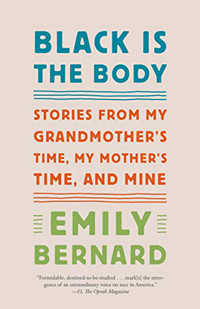 Emily Bernard, Black is the Body: Stories from My Grandmother's Time, My Mother's Time, and Mine (New York: Alfred A. Knopf, 2019), 218pp.
Emily Bernard, Black is the Body: Stories from My Grandmother's Time, My Mother's Time, and Mine (New York: Alfred A. Knopf, 2019), 218pp.
It is both difficult and dangerous to talk about racial identity, observes Emily Bernard. It's hard to know and to tell the truth. To speak wisely and to listen carefully. We all have biases, both conscious and unconscious. No person can transcend their personal history. There are contradictions, mysteries, and paradoxes. To talk about racism risks being labeled a racist. To avoid the issue altogether doesn't help anyone.
In this collection of a dozen essays, Bernard searches for "a language that would capture the totality of my experience, as a woman, a black American, a teacher, writer, mother, wife and daughter. I wanted to discover a new way of telling; I wanted to tell the truth about life as I have lived it." In particular, she wants to move beyond "the enduring narrative of black innocence and white guilt." And what a fascinating life story she brings to this difficult and dangerous task.
After earning her PhD at Yale, Bernard has taught at the University of Vermont in Burlington, which, we learn, is a very white town. Her physician father hails from Trinidad and attended the historically black Fisk University in Nashville (which is where she grew up), while her mother's family is from Mississippi. Bernard and her husband John, a white Italian American from the North, adopted twin girls from Ethiopia. They both teach African American Studies to primarily white undergraduates. In many ways, she says, their marriage is just as mundane as anyone's: you do the dishes, take out the trash, and help kids with homework. But as university professors and an interracial couple, the matters of race are endlessly fascinating and frustrating, both personally and professionally.
But is all this story-telling a healthy link to her family heritage, or a perpetual return to the pains of the past? Is telling these stories the salve or the wound itself, a way forward or part of the problem, a source of power or of humiliation? In her epilogue Bernard comes to a tentative conclusion: "It took me a while, it took the journey of this entire book, but I realized that there is a lesson, which was, in every scar there is a story. The salve is the telling itself." Which is to say that there is both despair and hope, rage and delight, ambivalence and fortitude: "the scar and the story are eternally connected."
Dan Clendenin: dan@journeywithjesus.net


